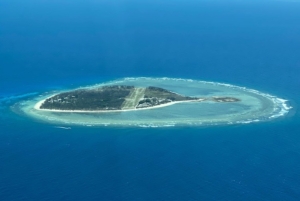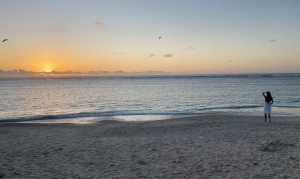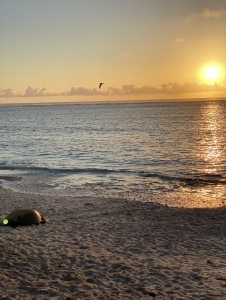Episode Resources
- Chasing Coral
- Sea Bin Project
- CO2 Lag
- Global Warming Natural Cycle
- Why Milankovitch (Orbital) Cycles Can’t Explain Earth’s Current Warming
- Wild Foundation
- Chasing Wild
- 50 Reefs
- Listen to “Breathe (Alexx Hermánn Remix)”
Do you like to breathe, by any chance? Around 80% of the oxygen you are breathing right now comes from the ocean. Not from the land. If you want to breathe, you need a healthy ocean.
In January this year, I surprised Leo and Melissa by taking them on a trip to Lady Elliot Island, which is a tiny tropical island about 40 minutes flight in a teeny tiny plane off the coast of Hervey Bay, Queensland. If you head down below this post you can check out some photos from our trip. I have to say, it was one of the most magical experiences I have ever had. And to share that with my family was so beautiful. Melissa gets terrible seasickness, so for her, it was not so pleasurable, but for Leo and me it was heaven, swimming amongst Green Sea and Loggerhead Turtles, as well as Cowtail Stingrays, just about every fish you could dream up in your imagination, and of course sharks. Lots of sharks.
One time, we went around this coral corner and could see a massive tail in a gap, and as Leo and I swam over the top, we woke up two Tawny Nurse Sharks, about 3m in length, and one of them turned around and shot straight through Leo’s legs. That was a moment we won’t forget! The experience was literally like swimming in an exotic aquarium. The water so, so thick with fish that they seemed to be in clouds. There were jellyfish everywhere too.
And the coral. Let’s speak about the coral. It turns out that Lady Elliot Island is one of the most untouched marine reserves in the world. The coral still looks the way you imagine — beautiful big coral heads, vibrant with colour. So vivid and brilliant, you almost can’t believe they’re real. So teeming with life that you’re left wordless and awestruck.
I was filled with gratitude at being able to bring my family to see such natural beauty. But what I didn’t realise is just how lucky we were to witness it at all…
Last night Leo and I watched an incredible documentary called Chasing Coral. I was moved to tears many times, because for me the ocean is something I hold very dear to my heart and could feel the pain of these silent heroes of the ocean. Surfing is one of my most loved activities on the planet, and since moving myself to a whole food plant-based diet, I have grown a deep connection and fondness for marine life. What I once used to see as food, I now see as friends. But these friends need coral. Our oceans need coral. An ocean without coral is like having no trees on the surface of the earth.
I want you to imagine something for a minute. Imagine all the trees from Washington DC to Maine suddenly dying. Or depending on where you are in the world, how about all the trees from London to Glasgow. Or all the trees from Sydney to Melbourne. Dead. Do you think the world might notice that? Do you think something might be done about it, if suddenly they all shrivelled up into brittle, brown skeletons?
In 2016, in the space of a few months, around 30% of the Great Barrier Reef died. In the years since it’s now reached 50%. Fifty per cent of the Great Barrier Reef, dead. These are reefs that took 500,000 years to grow. And that’s just one example. Coral is dying every day all around the world. About 50% of the world’s coral is now dead.
So what does this have to do with global warming and climate change? Well, 93% of the excess heat of climate change is absorbed by the ocean. If the ocean didn’t play this role for us, the average temperature on earth would go from 14.4°C to 50°C, or 58°F to 122°F. Keep in mind, that’s the average, which means many parts of the world would be uninhabitable. But while the ocean is busy saving our butts by absorbing this heat, it’s not without consequence. Rising temperatures cause coral bleaching and the loss of breeding grounds for marine life. Not good.
But it’s not just heat that the oceans absorb. The more greenhouse gases (like carbon dioxide) that we produce, the more the ocean absorbs them and the more acidic our oceans become, which can also cause coral bleaching.
It’s a shite show, guys. Let’s be real.
We as humans so often look up to the stars in awe and wonder, yet right here in front of us is an alien-like world. The ocean. The Great Barrier Reef is the largest living structure on planet earth. Yes, living structure. Coral is in fact, an animal.
The branch or mound that we often call “a coral” is actually made up of thousands of tiny animals called polyps. A coral polyp is an invertebrate that can be no bigger than a pinhead right up to a foot in diameter. Each polyp has a saclike body and a mouth that is encircled by stinging tentacles. The polyp uses calcium carbonate (limestone) from seawater to build a hard skeleton which protects the soft, delicate body of the polyp. Isn’t that amazing?
I know some people, despite all the scientific consensus, are still doubtful about global warming. But whether you believe global warming to be real or not, there’s an undeniable fact: the oceans are getting warmer, very fast. When you hear this, you can kind of imagine that all the water is getting warmer around the world, which as an average is true, but what tends to happen is that certain areas heat up significantly more than others, and these warmer bodies of water move around the globe via sea currents. This means that scientists can predict ahead of time what parts of the ocean are likely to warm up.
In Chasing Coral, they used that data to travel to various reefs around the world to take timelapse footage of coral. What they captured was heartbreaking to watch. Once healthy and thriving reefs were decimated into brown algae-covered dead zones with barely any marine life left. And I am not talking about years of footage. This happened in about 30 days. That’s one month, from thriving… to dead and decimated. And it all starts with coral bleaching, which is when the coral loses all its rich hues and turns into a stark, colourless white.
Nature was not designed to kill itself in a matter of days. We are looking face on at the inevitable eradication of an entire ecosystem within 30 years. Within our lifespan. This is not just coral, this is an ecosystem. All the life that coral sustains, gone. When that happens, the food chain gets terribly out of balance and unhealthy. And remember, if you want to keep breathing, then you need healthy oceans. (And we are not even touching here on other matters of ocean health like pollution. That’s a whole other topic and one that I recently invested in; a solution called Sea Bin Project, which you should definitely check out.
You might be thinking: but isn’t global warming just part of a natural cycle?
Mass coral bleaching can be tied to El Niño events. El Niño is a climate cycle in the Pacific Ocean that has a global impact on weather patterns. The cycle begins when warm water in the western tropical Pacific Ocean, which is above the NE of Australia, shifts eastward along the equator toward the coast of South America. El Niño is natural, but the heat content in our oceans are now exacerbating conditions so that we are now seeing these coral bleaching events happen without the assistance of a natural El Niño pushing that warm body of water around.
It’s true that in a natural cycle, the world can warm-up, and cool down, naturally, without any human interference. Over the past million years, there have been around 10 cycles, each lasting around 100,000 years. 80-90,000 of those years are ice age, with about 10-20,000 warmer years.
But here’s the kicker: in a natural cycle, CO2 lags behind the warming. But now CO2 is leading the warming. What does that all mean? It has something to do with what are called Milankovitch Cycles.
Milankovitch cycles, in a nutshell, are cyclical movements related to the Earth’s orbit around the sun, which affect the amount of sunlight — and therefore, energy — that Earth absorbs from the sun. There are three main Milankovitch cycles: include the shape of Earth’s orbit as it moves around the sun, the angle that Earth’s axis is tilted with respect to its orbit, and the direction that Earth’s spin axis is pointed (its precession).
I am going to come back to that word, precession because something just clicked for me. Each Milankovitch cycle is around 26,000 years. Remember that number.
It would be convenient for humans to have these cycles to blame so that we can continue on with our destructive habits, but the truth is, these cycles simply can’t explain all the climate change that has been taking place or explain the rapid warming Gaia has experienced, especially since the mid-20th Century.
No matter what way you look at it, it’s pretty hard to deny that the composition of the earth’s atmosphere has changed over the last century with huge spikes in CO2 from burning fossil fuels.
One other argument you will hear is that we are “coming out of an ice age so it’s natural for the earth to warm up”. Earth is in an interglacial period, which is a period of milder climate between Ice Ages. But based on Earth’s current orbital positions within the Milankovitch cycles, our planet should be getting cooler, not warmer. This is a trend that started more than 6,000 years ago. Pretty fascinating hey? I have been totally geeking out on this and came into this with a totally open mind, taking the view that there is no right or wrong.
Ok, so back to that word, precession, and that number, 26,000 years. You would have most likely heard of the Mayan Calendar and how it has something to do with 2012. It is in 2012 that it is believed Gaia, mother earth, shifted her consciousness into the Fifth Density, or 5D. The 3D to 5F shift, which is the highest period of consciousness that Gaia can supposedly experience. This gives birth to a New Paradigm, but this time around in the cycle with many of the almost 8 billion people clinging on to very base and dense energies, that’s a lot of energy to shift. So what then makes the shift happen? It’s referred to as a ‘Great Cleansing’, and it’s thought to be some sort of event that causes the collapse of the old reality.
What I found fascinating when diving into all of this is that the Milankovitch cycle is around 26,000 years in duration, and guess what happened 26,000 years ago from 2012, in 24,000 BC? It was the peak of the last Ice Age, the time around which modern humanity emerged, and also the beginning of the Great Cycle as predicted by the Mayan Calendar.
It’s all tied together — science and ancient wisdom are intersecting, and they’re both saying the same thing: Something is going on right now in our lifetime. It’s an incredible time to be alive, but this cycle greatly outlasts us, our children and our children’s children. But if we all don’t play our part now in bringing about the change we desire, what world will our children and grandchildren experience?
Coral is just the silent and largely unseen victim of our actions. Coral and the marine life that depends on them can’t share on social media, march in the streets or lobby governments for change. Coral do have one last sad but beautiful trick though. In a last-ditch attempt before their inevitable death, around the world, we started seeing coral turning bright fluorescent colours of purple, blue and yellow. This had never been seen before and turned out to be corals’ last chance at protecting themselves before they die by secreting a natural “sunscreen” to help protect themselves from the excess UV radiation that is associated with a bleaching event.
Beautifully heartbreaking. They are silently screaming for our attention and help.
So what can we do, right now? Yes, the problem seems overwhelmingly big, but nothing changes if nothing changes. We have to all start really looking at how we live. How we shop. We all have one very powerful tool at our disposal: the dollar. Where we use our dollars, pounds or euros can have an immediate impact.
Do you shop at your local farmer’s markets and take your own bags? Do you buy plastic-free wherever possible? Do you choose products made from recycled, biodegradable or compostable materials? Once you’ve bought an item and welcomed it into your home, do you stretch out its lifespan as long as possible? Do you then regift, repurpose or recycle it? Do you only spend money on things you truly need or value? Do you support companies with innovative environmental policies? Even more importantly, do you walk away from ones that don’t?
It’s not just voting with our dollars, it’s how we show up in our daily life too. Do you pick up the trash you walk past in the street? Do you turn the power off when it’s not in use? Do you avoid food wastage? Do you walk or ride instead of driving where possible? Do you walk your walk (not just talk the talk)? Do you lead by example? Do you have open — maybe even uncomfortable — conversations with your kids around the dinner table?
The people leading the charge, like the filmmakers of Chasing Coral, need our support. I have just set up a recurring monthly donation to the Wild Foundation to support the team at Chasing Wild so that they can continue to educate our children. It’s our children that need to know what they stand to lose. Even better, donate anonymously and feel how powerful it is to just give without recognition. I have also set up a recurring donation with the 50 Reefs Project which is an initiative aimed to identify an optimum portfolio of reefs for targeting coral reef conservation — fifty coral reefs that, together, have the potential of surviving the impacts of climate change and the ability to help repopulate neighbouring reefs over time. Imagine being the person who created that?! How incredible!
And here’s the thing… you can create something like that! Don’t wait for someone else. Take your inspiration and just make it happen. Decide on what that one next step is and take that step today. Not tomorrow. Because for some coral somewhere in the world right now, silently shining vivid fluorescent purple, yellow or blue, they don’t have a tomorrow. And they need your help.
I would love to hear from you, so please tag me @iamnickbroadhurst on social media. Please also leave me a comment below (I read every single one!). And if you could take a minute to leave me a review on iTunes I would be very grateful. Tell me what you want more of! I am at your service.
P.S. Always listen to your intuition (and your doctor or practitioner) before trying any new health or lifestyle practice.




